BC: Before Christ
AD: Anno Domini
bya: billion years ago
BCE: Before Common Era
CE: Common Era
c. : circa, (often preceding a date) approximately
pertaining to
phonetic symbols? of dialect?
archaeological periods?(https://en.wikipedia.org/wiki/List_of_archaeological_periods)
technology eras?
Most dates of periods are just proximation, I tidied up those dates and found that even wikipedia itself couldn’t align ‘em well. For example, the lasting dates of Western European Chalcolithic is 2200BC(which is the end of Neolithic)~x in https://en.wikipedia.org/wiki/Neolithic. But in https://en.wikipedia.org/wiki/List_of_archaeological_periods, copper age seems to become a subperiod of new stone age, and the end of Neolithic becomes 2000BC(200 years later). So whether Chalcolithic is actually a subset of broader Neolithic or not, I’ll just take copper age as a transition between new stone age and bronze age, regardless of the date, and most other dates of periods. (https://en.wikipedia.org/wiki/Iron_Age_Europe the end of Western European Iron Age is 1 AD but https://en.wikipedia.org/wiki/List_of_archaeological_periods here is 1 BC…)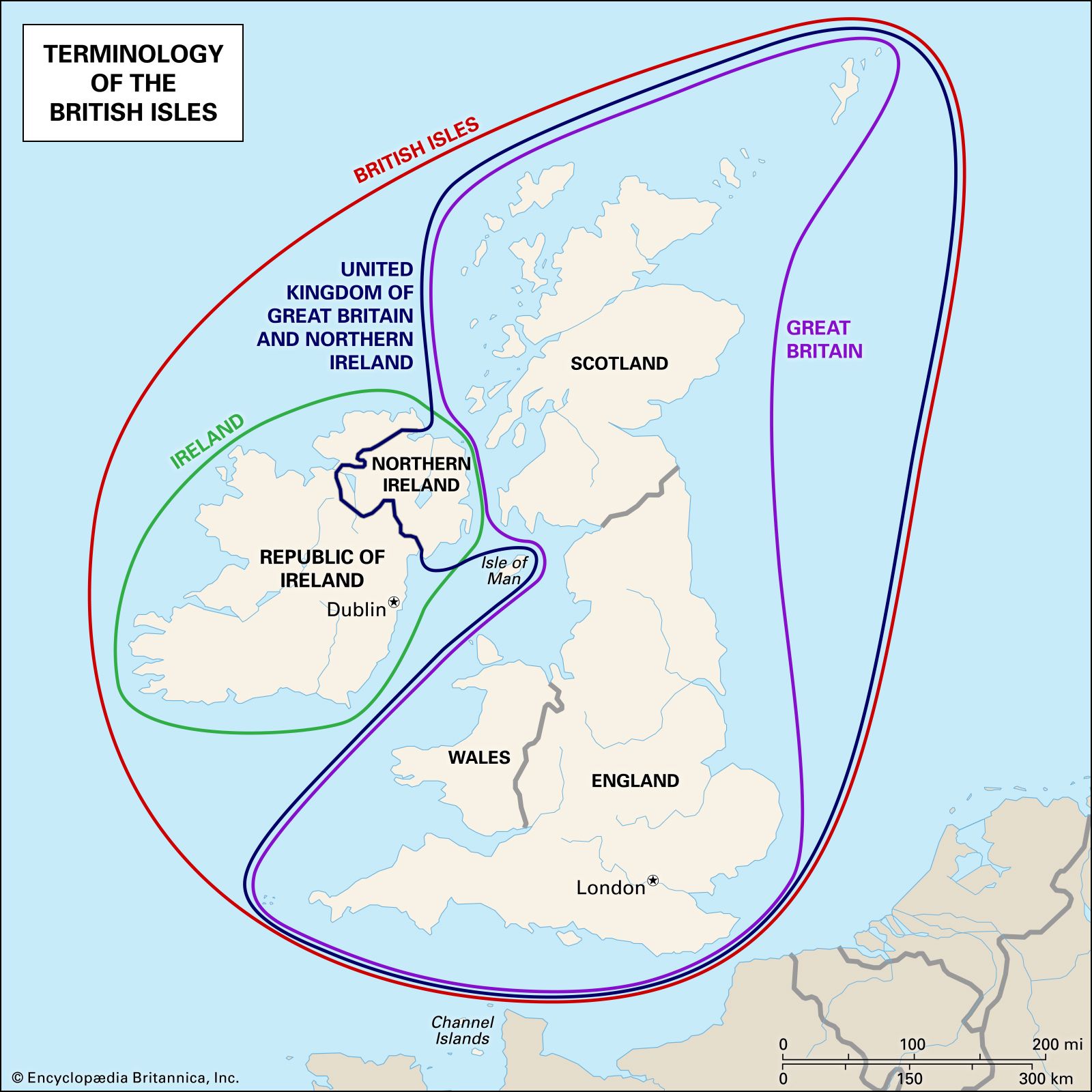 Terminology-British-Isles-United-Kingdom-Ireland-Great
Terminology-British-Isles-United-Kingdom-Ireland-Great
The British Isles are a group of islands off the northwestern coast of Europe. The largest of these islands are Britain and Ireland. (Smaller ones include the Isle of Wight.) In the Middle Ages, the name Britain was also applied to a small part of France now known as Brittany. As a result, Great Britain came into use to refer specifically to the island. However, that name had no official significance until 1707, when the island’s rival kingdoms of England and Scotland were united as the Kingdom of Great Britain.
https://www.britannica.com/story/whats-the-difference-between-great-britain-and-the-united-kingdom
最后要检查一遍文章里的Britain, Great Britain和British. 时态?
| Date | Eon/States/People | Subperiod | Relevant Events | Note |
| – 4.5 bya | Hadean | The Earth is formed out of debris, there's no life, temperatures are extremely hot, with frequent volcanic activity and hellish-looking environments. And the moon is formed. | Hence the eon's name comes from Hades, who is the god of the dead and the king of the underworld, in the ancient Greek religion and myth. | |
| 4 bya – 538.8 mya | The first form of life emerges, continents exist. | The 1st turining point of the evolution of Earth. “evolution” is noun of evolve, not evolvement. | ||
| 538.8 mya – present | Phanerozoic | Complex life dominate the ocean in a process known as the Cambrian Explosion(寒武纪生命爆发) and expands to land. Speaking of landmass, supercontinent forms and dissolves. | Phanerozoic means “visible life”, the etymology of which is Greek words “phaneros”(visable) and “zoe”(life) and “-ic”(of or pertaining to). | |
| 66 mya | End of Cretaceous(白垩纪) | Mammals became dominant on Earth after the extinction of the dinosaurs, caused by a asteroid/comet/meteor striking the Earth. | Asteroids are rocky, comets are icy, and meteors are much smaller and are the shooting stars that you see up in the sky. – NASA It's just a coincidence that "steroid" and "asteroid" look alike. They have the shared suffix "-oid," which means "to be like" (humanoid for instance). However, "aster-" and "ster" are unrelated. "Aster" is Greek for "star," so an asteroid is "star-like." The "ster-" in steroid comes from "sterol," which is a type of alcohol organic molecule, whose name can be traced back to the Ancient Greek "steros," meaning solid. – mdgraller from reddit | |
| 3.3 mya – 2000 BC | Stone Age | x hundred thousand years ago (x00, 000) | Modern humans originated in Africa, evovled from Homo erectus(upright human in Latin) | The 2nd turning point of the Earth, human emerges. Humans don't evolve by natural selection anymore, but by changing the environment to suit their genes.(? Isn't the evolution of brain a kind of natural selection) Homo: 人属, not a gay. |
| Paleolithic (pre c. 10000 BCE) The last Ice Age or Glacial Mesolithic (c. 10000 – 4500 BCE). | By the Mesolithic, Homo sapiens, or modern humans, were the only hominid species to still survive in the British Isles. At the end of the old stone age, agriculture revolution's eve, the population(x million) increases dozens of times compared the beginning of the old stone age(a hundred thousand). Stone age ended with the advent of metalworking. Though some simple metalworking of malleable metals, particularly the use of gold and copper for purposes of ornamentation, was known in the Stone Age, it is the melting and smelting of copper that marks the end of the Stone Age. | Prehistory predates recorded history, i.e. "before we had written records". History is the study of the past using written records , it's also the record itself. About 2.5 million years ago, writing was developed. archaeology/ˌɑː(r)kiˈɒlədʒi/, https://en.wikipedia.org/wiki/Prehistory 定义变了?three-age system全部属于prehistory? Prehistory, also known as pre-literary history,[1] is the period of human history between the first known use of stone tools by hominins c. 3.3 million years ago and the beginning of recorded history with the invention of writing systems. 没变,意思是西欧的prehistory史前期结束于公元前1年? | ||
| Neolithic(c. 4500 – 2500 BC) | Neolithic Revolution is comprised of the introduction of farming, domestication of animals, and change from a hunter-gatherer lifestyle to one of settlement. | The etymology of Neolithic is "neo-"(English prefix, new) and "lithos"(Greek root, stone) and "-ic"(English suffix, of/pertaining to), i.e. New Stone Age. The term 'Neolithic' was coined by Sir John Lubbock in 1865 as a refinement of the three-age system. | ||
| Iberian, Stonehenge | About 2000 years B.C. pre-celtic people had already settled in Great Britain. These were called the Iberians. Probably the came from Spain, which was also called the Iberian peninsula. |  European Peninsulas. European Peninsulas.
 Stone Henge Stone Henge |
||
| Transition | Copper Age | The Copper Age is an archaeological period characterized by regular human manipulation of copper, but prior to the discovery of bronze alloys. | Copper Age, Eneolithic(Latin), Chalcolithic(Greek) are synonyms. | |
| c. 2500 – 600 BC, Iberian? | Bronze Age | The Bronze Age is the second principal period of the three-age system proposed in 1836 by Christian Jürgensen Thomsen for classifying and studying ancient societies and history. It is also considered the second phase, of three, in the Metal Ages. | While copper is pure metal(Cu from Latin: cuprum 29), brass and bronze are copper alloys (brass is a combination of copper and zinc; bronze is a combination of copper and tin.) |
|
| c. 700 BC – 55 BC or AD 43, Celtic | Iron Age | Celtic conquers the Iberian, Iberian is/are? called ancient Briton, a part of Celtics are called Britons. (the origin of "europe" and "british"? england is named after "anglos" I know that). The "Iron Age" is defined by archaeological convention. It begins locally when the production of iron or steel has advanced to the point where iron tools and weapons replace their bronze equivalents in common use. The Iron Age is taken to end, also by convention, with the beginning of the historiographical record. This usually does not represent a clear break in the archaeological record. Just some convention, such as Roman conquests of Central and Western Europe, c. 800 AD the beginning of Viking Age as the end of Germanic Iron Age of Scandinavia. | In China, written history started before iron-working arrived, so the term is infrequently used. https://en.wikipedia.org/wiki/List_of_archaeological_periods It's interesting. And, does British prehistory includes bronze and iron? https://en.wikipedia.org/wiki/History_of_Europe, check it out. Latest prehistoric technology in the Near East – cultures in the Near East achieved the development of writing first, during their Bronze Age. Latest prehistoric technology in the rest of the Old World: Europe, India, and China reached Iron Age technological development before the introduction of writing there. 中国最早的文字甲骨文出现于商朝(前16世纪到前11世纪)。The oldest word in China, Oracle, emerges in Shang Dynasty(16 c. BC – 11 c. BC) | |
| Celtic | According to britain express, Celts gradually infiltrated Britain over the course of the centuries between about 500 and 100 B.C. There was probably never an organized Celtic invasion; for one thing, the Celts were so fragmented and given to fighting among themselves that the idea of a concerted invasion would have been ludicrous.
The Celts were a group of peoples loosely tied by similar language, religion, and cultural expression. They were not centrally governed, and quite as happy to fight each other as any non-Celt. They were warriors, living for the glories of battle and plunder. They were also the people who brought iron working to the British Isles. The basic unit of Celtic life was the clan, a sort of extended family.Clans were bound together very loosely with other clans into tribes, each of which had its own social structure and customs, and poibly its own local gods. |
以上是prehistory, prehistory分为Britain和Ireland 早期人类迁移 早期人类迁移 |
||
| c. 55 BCE or AD 43 – 407 CE, Mixture, Complex | Roman, Classical period, Classical antiquity? | first landing, as the beginning of classical antiquity | Roman general and future dictator Gaius Julius Caesar first landed in Britain on August 26th, 55 BC. Then 54 BC he launched another invasion of the British Isles, didn't result in a full Roman occupation either. | About Ancient Rome? https://en.wikipedia.org/wiki/History_of_Europe , I'm more interesting about that during this period. |
| AD 43, actual conquering | In AD 43, southern Britain became part of the Roman Empire, and Romans took the Thames estuary Londinium(London) as gathering place. On Nero's accession Roman Britain extended as far north as Lindum (Lincoln). Paulinus, the conqueror of Mauretania (modern-day Algeria and Morocco), then became governor of Britain. | |||
| AD 58 | Rome controls much of south-eastern Britain, north and west are remain beyond its grasp. Roman army is bogged down on the border of modern-day Wales. | |||
| AD 60, Butchery | Roman army arrived in North Wales, arrived on the island of Anglesey, to kill Druids, to destroy Britons' culture. Paulinus penned up the last resistance and massacred the last of the druids and burnt their sacred groves, 'cause druids, religion leaders of Celtic society, can unify people. After that, Britain is transformed, new roads are built, they still exist. Lincoln, York, Chester, Bath, London, those cities are built at that time. Roman arena comes. | 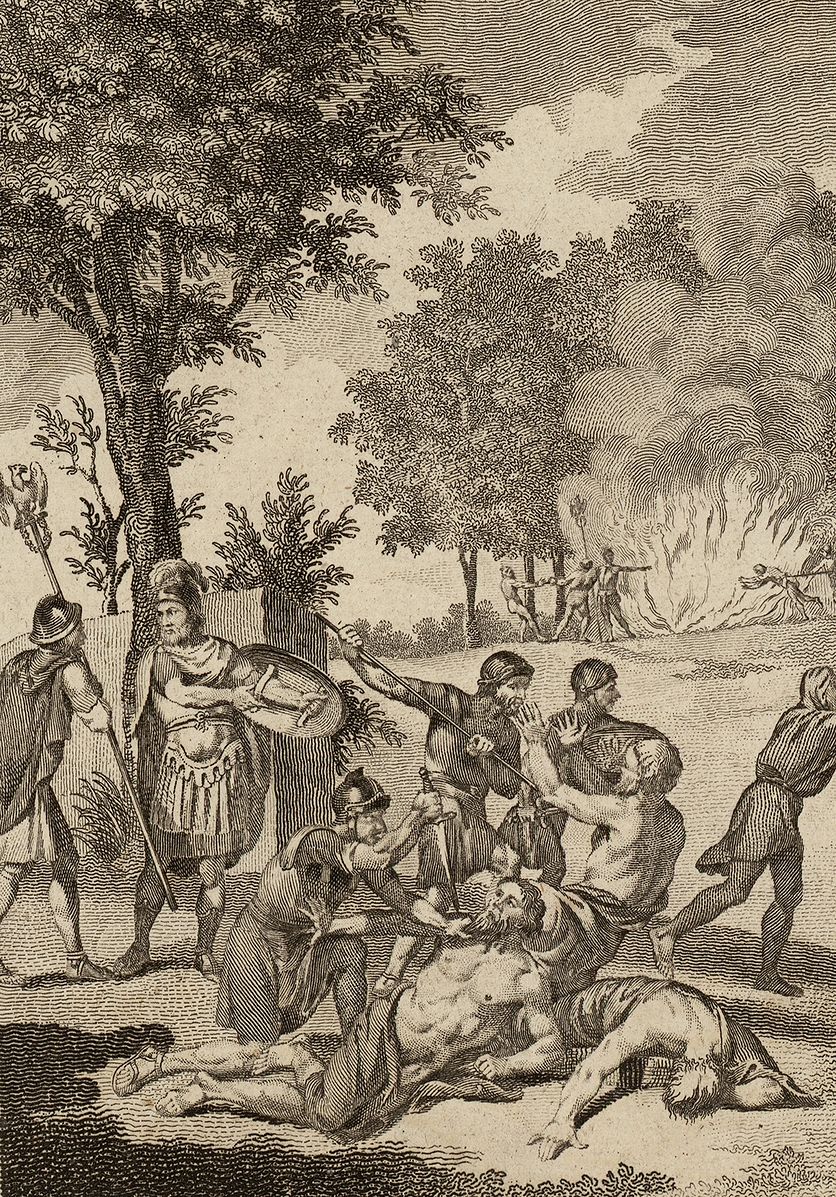 Romans murdering Druids and burning their groves cropped. Most written records are from Tacitus. Romans murdering Druids and burning their groves cropped. Most written records are from Tacitus. |
||
| AD 122, Hadrian's Wall | Romans have been sealed off from the rest of Roman Britain by a feat of engineering 75 miles long, in places 6 meters high, from coast to coast, with a fort every mile. Hadrian's Wall was built in AD 122 for King of Ancient Rome Hadrian to fight against Celtic from northern Great Britain. In hadrian's words, they wanna "separate Romans from the barbarians" to the north. They are Picts, "Painting People"(tattoos), who lived in Scotland. | .svg.png) Province of Britain in the Roman Empire in 125 AD Province of Britain in the Roman Empire in 125 AD |
||
| AD 367, Barbarians from Scotland, Ireland and Germany co-ordinate their attacks and launch raids on Roman Britain. | For 300 years, the people of today's Scotland have remained free. They are a ferocious force. Scotland i.e. North Britain, Scots i.e. Picts, fight Rome till the end. And there're Goths, the Goths were a nomadic Germanic people who fought against Roman rule in the late 300s and early 400s A.D., helping to bring about the downfall of the Roman Empire, which had controlled much of Europe for centuries. |
Visigoth was the name given to the western tribes of Goths, while those in the east were referred to as Ostrogoths. Ancestors of the Visigoths mounted a successful invasion of the Roman Empire, beginning in 376, and ultimately defeated them in the Battle of Adrianople in 378 A.D. | ||
| AD 376, From what is now Germany, the Visigoths storm Rome. | Visigoth was the name given to the western tribes of Goths, while those in the east were referred to as Ostrogoths. Ancestors of the Visigoths mounted a successful invasion of the Roman Empire, beginning in 376, and ultimately defeated them in the Battle of Adrianople in 378 A.D. | The Goths were a nomadic Germanic people who fought against Roman rule in the late 300s and early 400s A.D., helping to bring about the downfall of the Roman Empire, which had controlled much of Europe for centuries. | ||
| Christianity | Constantine converted to Christianity in 312 at the Battle of Milvian Bridge, where he fought against Western Emperor Maxentius to take his place on the throne. Christianity was a mere cult, Constantine's conversion turned Rome into a Christian empire. As the Romans withdraw, the Christianity they introduced to these shores survives. 5th century, Irish pirates come to Britain for slaves. Patric is dragged to Ireland. Patric preaches in the local language to normal Irish Celts! He's called Saint Patric, He succeeds in establishing religion where the Romans failed. |
From 406 AD, no new coins are sent to Britain. 410 AD, Rome can no longer police the country. Local warlords set themselves up. It's the death of Romano-Britain. | ||
| retreat/withdraw of military | For the first time in 800 years, Rome falls. Britain, too, is in chaos. Ceramics grind to a halt. From 406 AD, no new coins are sent to Britain. 410 AD, Rome can no longer police the country. Local warlords set themselves up. It's the death of Romano-Britain. 410 Roman army retreated. As the Roman occupation of Britain was coming to an end, Constantine III withdrew the remains of the army in reaction to the Germanic invasion of Gaul with the Crossing of the Rhine in December 406. |  |
||
| c. AD 407 – AD 597, Local Warlords? total wikipedia | Sub-Roman Britain is the period of late antiquity in Great Britain between the end of Roman rule and the Anglo-Saxon settlement. The term was originally used to describe archaeological remains found in 5th- and 6th-century AD sites that hinted at the decay of locally made wares from a previous higher standard under the Roman Empire. It is now used to describe the period that commenced with the recall of Roman troops to Gaul by Constantine III in 407 and to have concluded with the Battle of Deorham in 577. The period of sub-Roman Britain traditionally covers the history of the area which subsequently became England from the end of Roman imperial rule, traditionally dated to be in 410, to the arrival of Saint Augustine in 597. The date taken for the end of this period is arbitrary in that the sub-Roman culture continued in northern England, and longer in western England like Wales. |
The term "post-Roman Britain" is also used for the period, mainly in non-archaeological contexts. Popular (and some academic) works use a range of more dramatic names for the period: the Dark Ages, the Brythonic Age(Briton人的), the Age of Tyrants(暴君), or the Age of Arthur(亚瑟王). |
||
| c. AD 597 – AD 1485 | Medieval, mixture | Anglo-Saxon England (597–1066) | Anglo-Saxon England or Early Medieval England, existing from the 5th to the 11th centuries from the end of Roman Britain until the Norman conquest in 1066, consisted of various Anglo-Saxon kingdoms until 927, when it was united as the Kingdom of England by King Æthelstan (r. 927–939). It became part of the short-lived North Sea Empire of Cnut the Great, a personal union between England, Denmark and Norway in the 11th century. The Anglo-Saxons migrated to England from mainland northwestern Europe after the Roman Empire abandoned Britain at the beginning of the fifth century. Anglo-Saxon history thus begins during the period of sub-Roman Britain following the end of Roman control, and traces the establishment of Anglo-Saxon kingdoms in the 5th and 6th centuries (conventionally identified as seven main kingdoms: Northumbria, Mercia, East Anglia, Essex, Kent, Sussex, and Wessex); their Christianisation during the 7th century; the threat of Viking invasions and Danish settlers; the gradual unification of England under the Wessex hegemony during the 9th and 10th centuries; and ending with the Norman conquest of England by William the Conqueror in 1066. Anglo-Saxon identity survived beyond the Norman conquest, came to be known as Englishry under Norman rule, and through social and cultural integration with Celts, Danes and Normans became the modern English people. Before Æthelstan, |
Throughout this article Anglo-Saxon is used for Saxon, Angle, Jute or Frisian unless it is specific to a point being made; "Anglo-Saxon" is used when the culture is meant as opposed to any ethnicity. ??? What does this annotation mean? Need understand the "Historical Context", the point is to organize the whole history in my mind but not this stupid article. 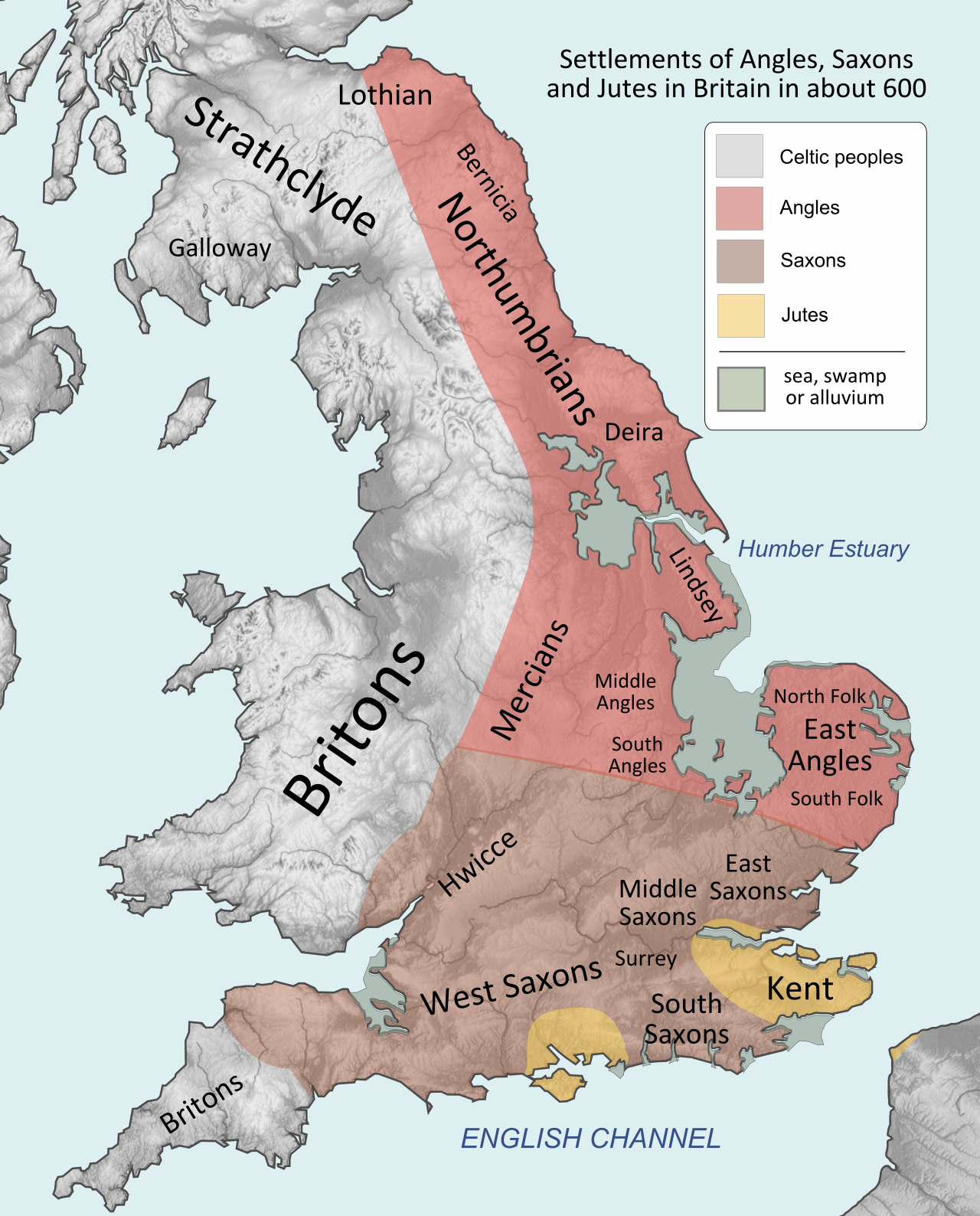 after settlement after settlement |
| Heptarchy(597–829) and Unification | By 600, a new order was developing, of kingdoms and sub-Kingdoms. The medieval historian Henry of Huntingdon conceived the idea of the Heptarchy, which consisted of the seven principal Anglo-Saxon kingdoms (Heptarchy literal translation from the Greek: hept – seven; archy – rule). By convention, the Heptarchy period lasted from the end of Roman rule in Britain in the 5th century, until most of the Anglo-Saxon kingdoms came under the overlordship of Egbert of Wessex in 829. This approximately 400-year period of European history is often referred to as the Early Middle Ages or, more controversially, as the Dark Ages. Although heptarchy suggests the existence of seven kingdoms, the term is just used as a label of convenience and does not imply the existence of a clear-cut or stable group of seven kingdoms. The number of kingdoms and sub-kingdoms fluctuated rapidly during this period as competing kings contended for supremacy. Egbert of Wessex briefly unified, but split again after his death. From 874 to 879 the western half of Mercia was ruled by Ceowulf II, who was succeeded by Æthelred as Lord of the Mercians. Alfred the Great of Wessex styled himself King of the Anglo-Saxons from about 886. In 886/887 Æthelred married Alfred's daughter Æthelflæd. On Alfred's death in 899, his son Edward the Elder succeeded him. When Æthelred died in 911, Æthelflæd succeeded him as "Lady of the Mercians", and in the 910s she and her brother Edward recovered East Anglia and eastern Mercia from Viking rule. Edward and his successors expanded Alfred's network of fortified burhs, a key element of their strategy, enabling them to go on the offensive. When Edward died in 924 he ruled all England south of the Humber. His son, Æthelstan, annexed Northumbria in 927 and thus became the first king of all England. Cnut (/kəˈnjuːt/; Old English: Cnut cyning; c. 990 – 12 November 1035, born in Denmark!), also known as Cnut the Great and Canute, was King of England from 1016, King of Denmark from 1018, and King of Norway from 1028 until his death in 1035. The three kingdoms united under Cnut's rule are referred to together as the North Sea Empire. |
  |
||
| Norman Conquest (1066) | The Norman Conquest (or the Conquest) was the 11th-century invasion and occupation of England by an army made up of thousands of Norman, Breton, Flemish, and French troops, all led by the Duke of Normandy, later styled William the Conqueror. |
Christmas Day, 1066, great monument of Anglo-Saxon. Foreigner new king, French, to be crowned in Westminster Abbey. Walliam. Battle of Hastings. Normans. French? the Harrying of the North. 北方掠夺战?rebellions. and brutal slaughter. Normans build a lot of strongholds. estates owned by 4000 Saxon lords are divided between 200 Norman barons.  |
||
| AD 1085 | 1085, commissions the most ambitious census in Europe. Cement Norman ownership. allow Walliam to tax his population as never before. Domesday Book, the book of judgement末日审判书。200million words, in Latin, in foreign language. It records 8 million acres of cultivated land. Of the 6 richest people in the whole of British history, 4 are Norman lords. Walliam, the Bastard Duke of Normandy, has become the conqueror, most powerful monarch. And they built a lot of huge cathedrals. | |||
| AD 1096, crusades | 1096,Payne Peverel is preparing for war, finally he become a baron. Normans join Crusades, enrich themselves with booty, carve out for themselves fiefdoms and estates. 1099, the first attack on the holy city Jerusalem. Thousands of Muslim and Jewish inhabitants are slaughtered. It continues for 200 years. Funded by harsh levies, peasants provide for the war, high tax makes the people's livelihood difficult. | The Crusades were a series of religious wars initiated, supported, and sometimes directed by the Christian Latin Church in the medieval period.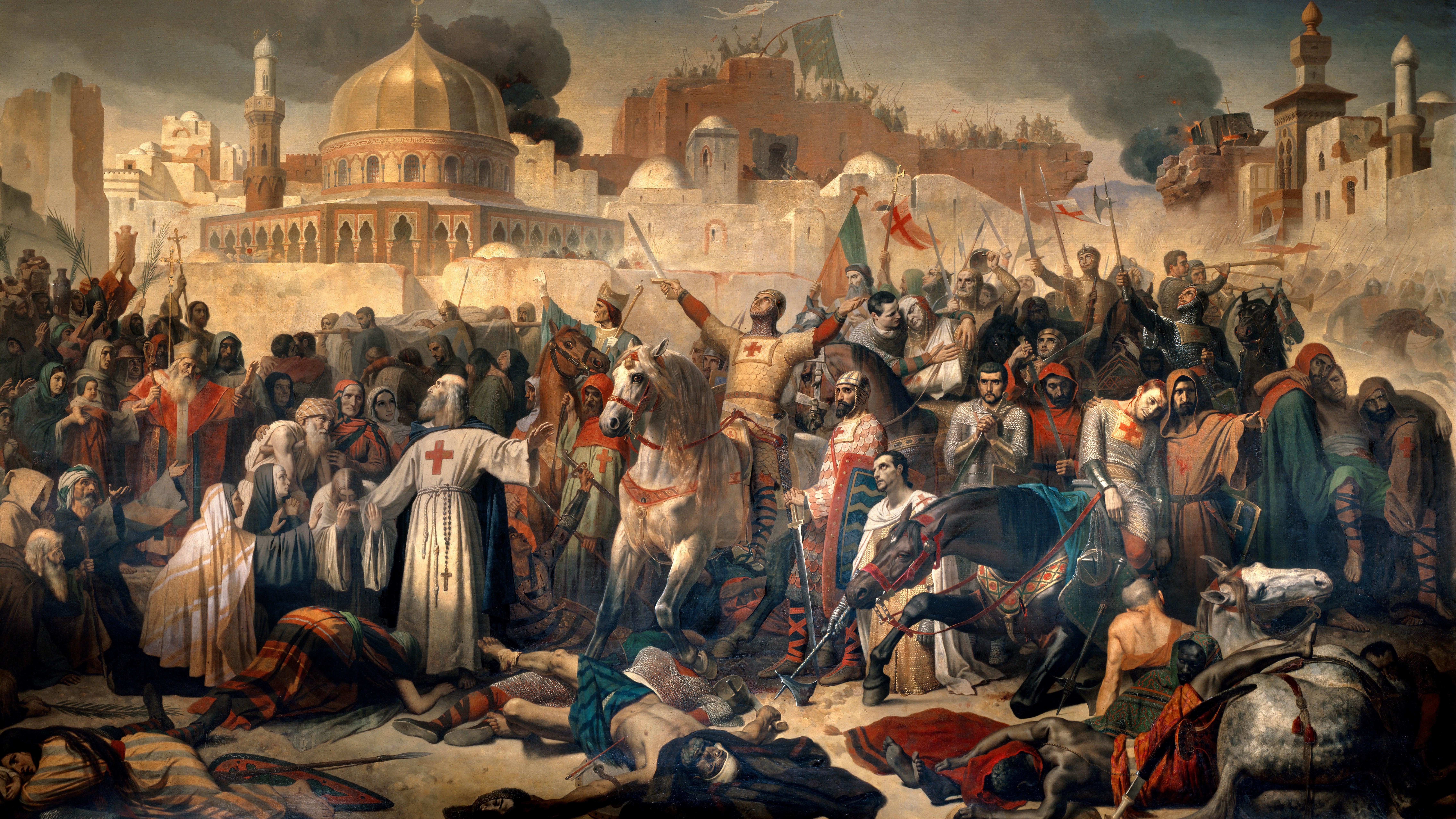 |
||
| AD 1315, mistreated British under Normans' reign | 1315, farming catastrophe, harvests are hard, one of the worst famines. 1317, poachers poaching in Norman royal forests. all common men must be practiced bowman. Robin Hood, heroes. a metaphor for fairness. |  Statue of Robin Hood near Nottingham Castle by James Woodford, 1951 Statue of Robin Hood near Nottingham Castle by James Woodford, 1951 |
||
| AD 1348, The Black Death | 1348, black rats from the continent. a merchant ship from France with deadly cargo.The fleas they carry are agents of death for a disease. The Black Death. Blood clots can block capillaries in fingertips and toes. The gangrenous flesh gives the plague the name Black Death. Bubonic plague becomes pneumonic plague then.腺鼠疫变成肺鼠疫。 Village after village lose up to half their population, the disease spreads, across the sea to Ireland. Like a nuclear holocaust. |
 Acral gangrene due to plague Acral gangrene due to plague  Pieter Bruegel's The Triumph of Death reflects the social upheaval and terror that followed the plague, which devastated medieval Europe. Pieter Bruegel's The Triumph of Death reflects the social upheaval and terror that followed the plague, which devastated medieval Europe. 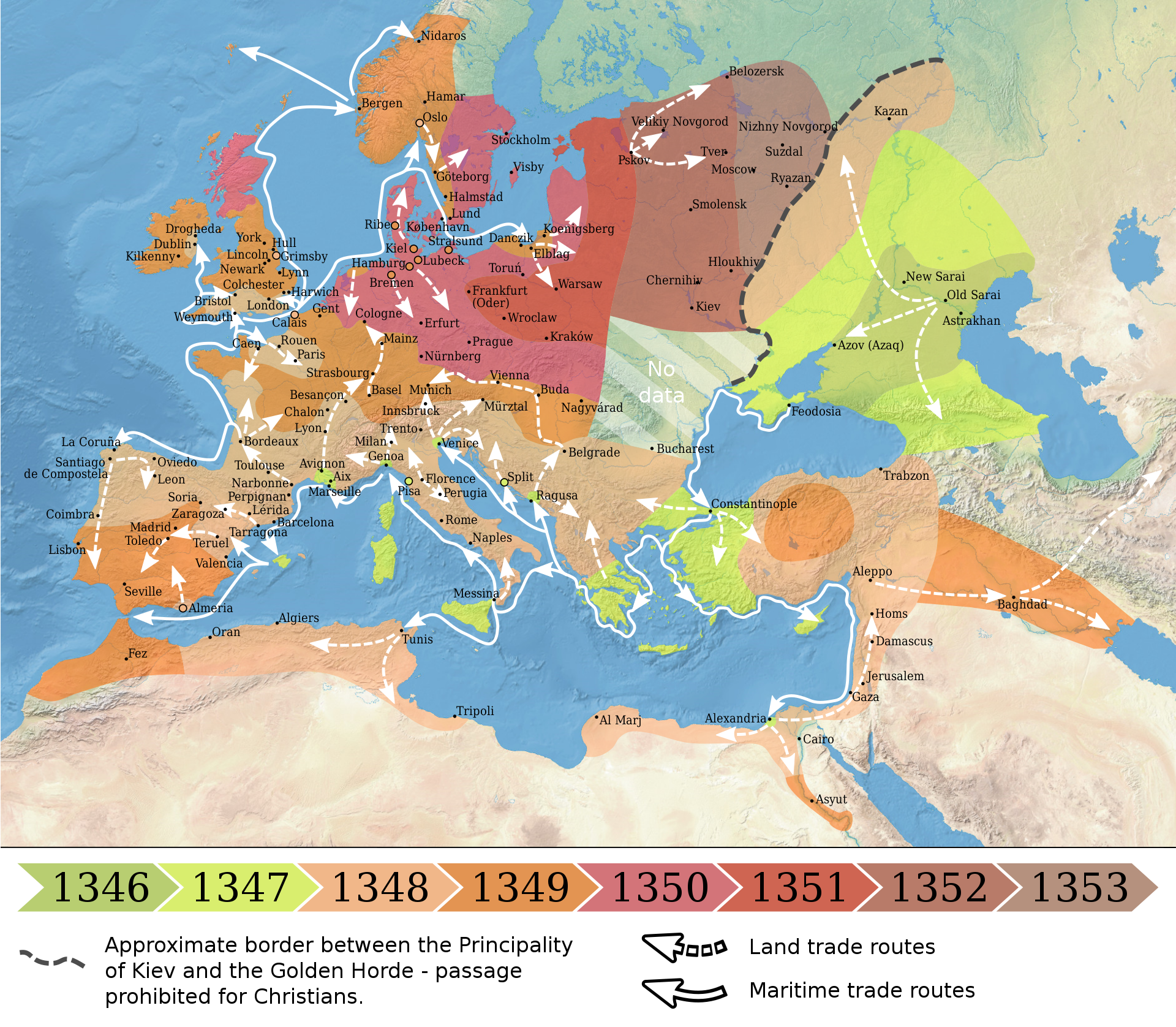 |
||
| After plague, The Peasants' Revolt, End of Serfdom | Half the population may be dead, but the survivors of the plague will gain new opportunities.Vacant land is taken up by the plague's survivors. 1381, life is changing. With a shortage of labor, the wages of people have risen substantially. (substance = essence) It's the beginning of a more modern relationship between employer and employed man or woman. But lords are threatened. They try to fix wages at pre-plague levels. Even to pass laws telling peasants what to eat and wear, and a harsh new poll tax. Fobbing in Essex, people refuse to pay. 1383, 5.30, Brentwood, poll tax. peasant revolution, Brentwood's rebellion. It sparks the first great popular uprising in British history. 陈胜吴广?The peasants' revolt. Their aim, an end to serfdom.农奴制终结 With in a fortnight (fourteen nights OLD ENGLISH), the Essex rebels are joined by others from Kent to march on London. Then from London, revolt spreads to towns and villages across the country. It sets in progress the first steps to a modern woking life. Within two generations, serfdom has all but collapsed. But within a month, the rebel leaders are rounded up and executed. 30 are from Essex (5 from Fobbing). The Peasants' Revolt sets England apart. A land of personal freedoms. |
|||
| AD 1415 | Agincourt, France, 1415, 10.25, England is at war. The latest offensive in a century of conflict with France. 英法百年战争中英国的最后一次进攻。(两次百年战争Second Hundred Years' War,1689年-1815年)The English face twice their number on the battlefield. The french force is 15,000 strong. Over half are knights and noblemen. More than three-quarters of the English army are archers. The English longbow. No enemy soldier will face a comparable rate of fire for over 400 years??? Just archer??? 14th century, finally writes the common man into the history books. not just dictated by royalty, nobility and clergy. England wins the latest offensive. England is transformed! But this same free spirit will trigger a century of religious mayhem and civil war. | |||
| Scotland in the Middle Ages (400–900–1286–1513) | Scotland was divided into a series of kingdoms in the early Middle Ages, i.e. between the end of Roman authority in southern and central Britain from around 400 CE and the rise of the kingdom of Alba in 900 CE. Of these, the four most important to emerge were the Picts, the Gaels of Dál Riata, the Britons of Alt Clut, and the Anglian kingdom of Bernicia. After the arrival of the Vikings in the late 8th century, Scandinavian rulers and colonies were established on the islands and along parts of the coasts. In the 9th century, the House of Alpin combined the lands of the Scots and Picts to form a single kingdom which constituted the basis of the Kingdom of Scotland. | The Picts were a group of peoples who lived in Britain north of the Forth–Clyde isthmus in the Pre-Viking, Early Middle Ages. https://en.wikipedia.org/wiki/Picts | ||
| Wales in the Middle Ages (411-1542) |  |
|||
| c. AD 1485 – c. 1800 CE | Post-medieval, Early Morden? | Some scholars date the beginning of Early Modern Britain to the end of the Wars of the Roses and the crowning of Henry Tudor in 1485 after his victory at the battle of Bosworth Field. Henry VII's largely peaceful reign ended decades of civil war and brought the peace and stability to England needed for art and commerce to thrive. A major war on English soil would not occur again until the English Civil War of the 17th century. The Wars of the Roses claimed an estimated 105,000 dead. | Norman诺曼-Plantagenet金雀花(勇敢的心)-Tudor(都铎)-stuart斯图亚特(议会分为支持国王的托利党和反对国王的辉格党)-Hanover汉诺威-Saxe-coburg and Gotha, Windsor温莎王朝 |
|
| Tudor period (1485–1603) | In England and Wales, the Tudor period occurred between 1485 and 1603, and included the Elizabethan period during the reign of Elizabeth I (1558–1603). The Tudor period coincides with the dynasty of the House of Tudor in England, which began with the reign of Henry VII. Historian John Guy (1988) argued that "England was economically healthier, more expansive, and more optimistic under the Tudors" than at any time since the Roman occupation. 1539, Glastonbury Abbey. Henry the VIII's relationship with the church has broken down, he pushes England closer to war with Catholic Europe. In the past 300 years, England has changed beyond recognition. But a third of all land remains owned by the Church. Now Henry has broken with the Pope, he wants it, it made England a target for all catholic countries in Europe. 1539, 11.15, abbot was hanged. In four years Henry takes control of all 8000 monasteries in England, adding into the royal coffers by billions in today's money. What will transform Henry's reign, is an invention. printing press. Paper from China and the Middle East, made from water and shredded rags. Before the printing press came to England, a single scribe could take over a year to copy out a book by hand. But now, merchant Caxton's printing press can produce hundreds of books in weeks. Compare it to the Internet. Suddenly, they have access to printed news and information! There's a case for saying it was the most important invention. This is the first time??? the English language comes to the printed page. maybe more important than the Internet, it allowed to disseminate ideas. Revolutionary! 1539, one book explodes onto the scene! The first official English language Bible. with no Christ or Papal, but Henry, push a step closer to war with Catholic Europe. Cast Cannons! The improvement operation is paid for by a wealthy parson, William Levett. On a Sunday he preaches from Henry's Bible, during the week he bankrolls weapons research.XD This was an innovation that would set the mark in gunnery for the next three centuries. It turns England into one of the biggest arms manufacturers in Europe and helps secure borders. |
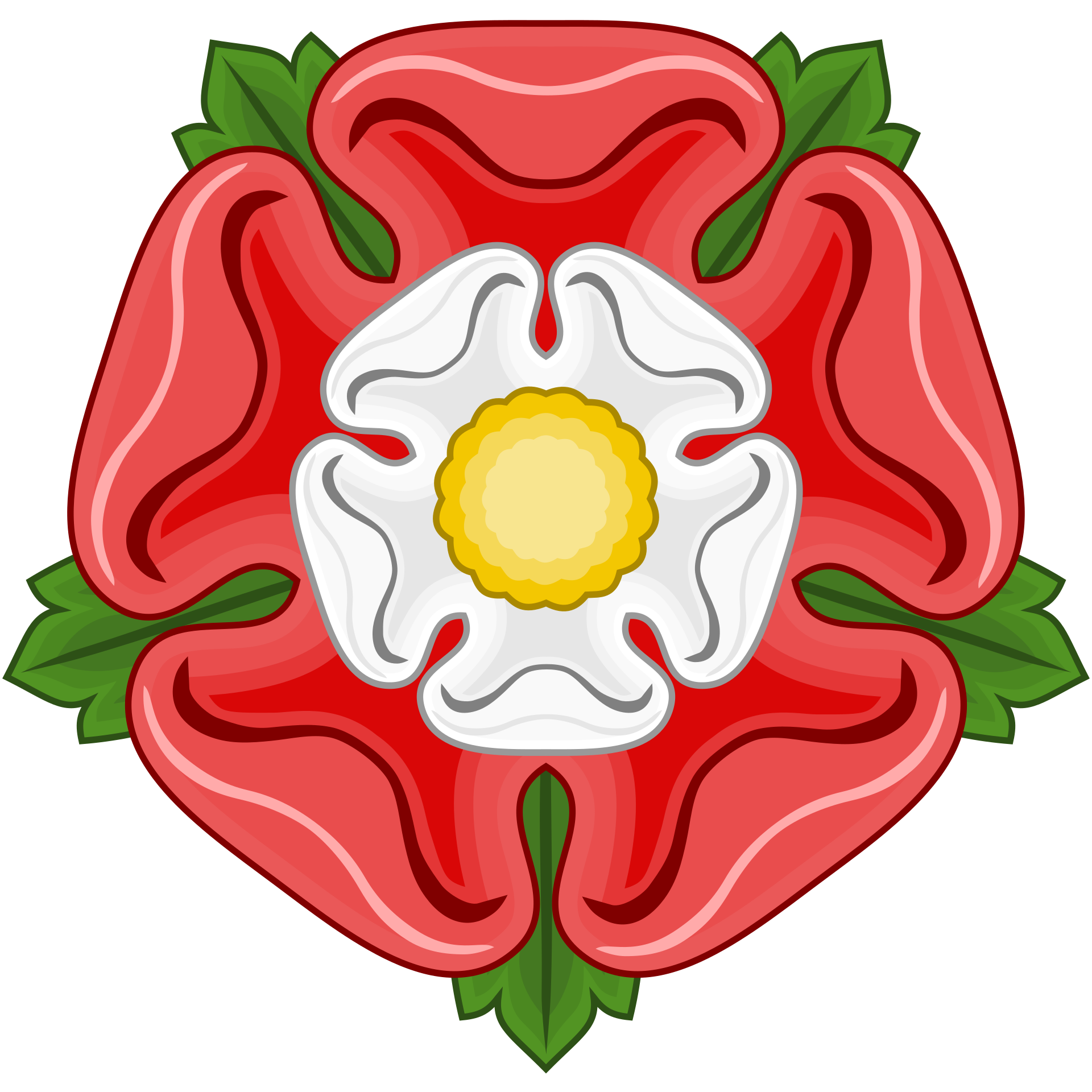 |
||
| Tudor period (1485–1603), Tudor conquest of Ireland | ||||
| Tudor period (1485–1603), English Renaissance | The English Renaissance can be hard to date precisely, but for most scholars, it begins with the rise of the Tudor Dynasty (1485–1603) and reaches its cultural summit during the 45-year reign of the final Tudor monarch, the charismatic Elizabeth I (1558–1603). | |||
| Tudor period (1485–1603), Elizabethan era (1558–1603) | When Elizabeth 1 is on the throne, the European powers are focusing their attention on getting wealth from beyond the ocean. South America is being colonized and looted by Spain, England's great rival. Silver and gold have transformed Catholic Spain into a superpower. It's difficult to conceive the scale of the Spanish empire, covering much of South America, with vast quantities of gold travelling to Spain and enriching the country. So, the Spanish Empire is vastly bigger and more important than little England. England looks enviously on. 1579, 3.1, the Pacific Ocean, England wanna have its share of the Spaniards' new wealth. Golden Hind vs Cacafuego, Golden Hind(the first English ship to(to??) sail into the Pacific) captain privateer Francis Drake, secretly backed by Queen Elizabeth 1. They have 15 cannons! It's one of the biggest heists in history. And they're building one of the greatest fighting machines the world ever seen, the Royal Navy. Jealous of Spain's riches, England's new power at sea (Royal Navy) begins a radical transformation of the nation, and kick-starts its overseas adventures. |  The Spanish Armada fighting the English navy at the Battle of Gravelines in 1588. The Spanish Armada fighting the English navy at the Battle of Gravelines in 1588. |
||
| First British Empire(1583-1783) | English overseas possessions (1583–1707) Americas, Africa and the slave trade Rivalry with other European empires Scottish attempt to expand overseas "First" British Empire (1707–1783) Loss of the Thirteen American Colonies 1769, the South Pacific, Lieutenant James Cook, sail off the edge of the map, to go in search of the fabled southern continent. After six months at sea, he found it. For 50,000 years(全球通史p19, from Asia), they are the first visitors. He claims the land for Britain, calling it New South Wales. In this age of imperial expansion, Australia, it will add three million square miles to the British Empire(760万平方公里). Cook writes, "The great quantity of plants collected in this place occasion my giving it the name Botany Bay." Sydney.(???没看懂grammar) King George III makes him director of the new Kew Gardens. Amongst the 30,000 specimens he brings home are 1,400 plants never seen before in Britain. His triumph inspires imitators, people commission plant hunters to find and bring plants back. | |||
| Jacobean era (1567–1625) | King James VI of Scotland has inherited the English throne from his mother's cousin, Elizabeth. James is the first monarch to rule both Scotland and England. He's both James VI and I. His son is Charles I(1600-11-19~1649-1-30), the King of England, Scotland and Ireland(1625-3-27~1649). Printing, Protestantism, and the spread of education have turned the English into one of the most literate people in the world.Over 70 percent of Londoners can read. Opposition to the King and his government begins to spread across the British Isles. Personal freedoms were hard fought for. | The Jacobean era succeeds the Elizabethan era and precedes the Caroline era.  King James VI and I by Mijtens (1621) King James VI and I by Mijtens (1621) |
||
| Union of the Crowns (1603) | King James devised new coats of arms and a uniform coinage._(2022).svg.png) |
 |
||
| Caroline era (1625–1642) | King James VI of Scotland has inherited the English throne from his mother's cousin, Elizabeth. James is the first monarch to rule both Scotland and England. He's both James VI and I. His son is Charles I(1600-11-19~1649-1-30), the King of England, Scotland and Ireland(1625-3-27~1649). Printing, Protestantism, and the spread of education have turned the English into one of the most literate people in the world.Over 70 percent of Londoners can read. Opposition to the King and his government begins to spread across the British Isles. Personal freedoms were hard fought for. 1640, newly elected member for Cambridge enters Parliament, Oliver Cromwell. He, puritan farmer, leads Britain through the most turbulent era in its history. In Cromwell's time, the King is free to call and dismiss MPs when he sees fit. But this sitting(can it be 'his sitting'?) will change it. It's now Parliament's opportunity to ensure that it can never happen again. the Palace of Westminster has been the heart of lawmaking and taxation for centuries. Cromwell demanded the release of John Lilburne. 1642, 1.4, Charles intends to arrest the rebel MPs in(why not at) the House of Commons. But they have been tipped off and escaped. He's caught in a situation that his own Parliament are defying him. That's the break between the monarch and the Parliament, and there begins the English Civil War. Then Charles abandons London, London becomes a Parliament stronghold. It became a civil war within communities, where neighbors might find themselves on opposite sides of the conflict. This is a conflict which is fundamental to the future of Britain, it can only now be resolved by war. It's a hinge on which the British history turns. 1500 men are dead, both sides claim victory, stalemate. | The Caroline era is the period in English and Scottish history named for the 24-year reign of Charles I (1625–1649). The term is derived from Carolus, the Latin for Charles. The Caroline era followed the Jacobean era, the reign of Charles's father James I & VI (1603–1625), overlapped with the English Civil War (1642–1651), and was followed by the English Interregnum until The Restoration in 1660. It should not be confused with the Carolean era which refers to the reign of Charles I's son King Charles II. 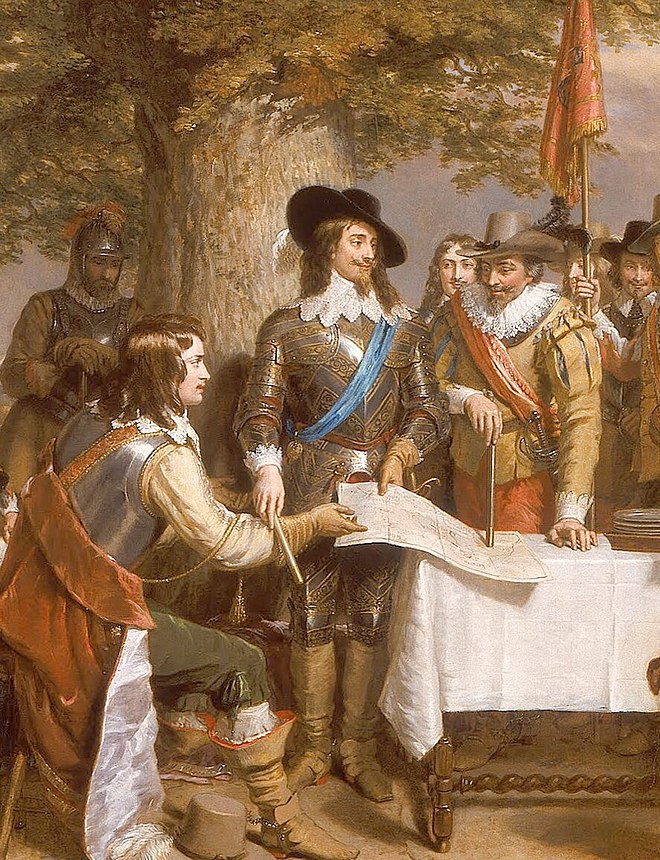 King Charles I, in blue sash, holding a council of war before the Battle of Edgehill in 1642; the cavalry commander Prince Rupert is seated left. King Charles I, in blue sash, holding a council of war before the Battle of Edgehill in 1642; the cavalry commander Prince Rupert is seated left. |
||
| English Civil War (1642–1651) | Parliament created the New Model Army. Then they beats the King, the King surrenders and is put to death for treason. 1649.1, Oliver Cromwell signs the King's death warrant. This is the moment when it is decided the Britain will not become an absolute monarchy, Britain will become a constitutional monarchy. 英国最后一个试图君主专制的King,之后就是君主立宪的时代。 |  The Battle of Naseby, 14 June 1645; Parliamentarian victory marked the decisive turning point in the English Civil War. The Battle of Naseby, 14 June 1645; Parliamentarian victory marked the decisive turning point in the English Civil War. |
||
| English Interregnum (1651–1660)空位期, associate with Korea?? | The Interregnum was the period between the execution of Charles I on 30 January 1649 and the arrival of his son Charles II in London on 29 May 1660 which marked the start of the Restoration. During the Interregnum, England was under various forms of republican government (see Commonwealth of England; this article describes other facets of the Interregnum). | |||
| Restoration (1660) | London, 1666, 9.2, after midnight. A fire, the worst inferno in London until the Blitz(德国闪电战). It's a disaster that will destroy London. All on fire, and flaming at once. On the third day, whole streets are blown up to create firebreaks(炸毁,防火障). The fire swallows St. Paul. Four-fifths of the old city gone, 80,000 homeless. A city 1,600 years in the making lost in four days. But a new capital rises, the city reinvents itself, in stone this time. First new London, then Newcastle, Edinburgh and Dublin. At London's heart, one of Britain's greatest buildings, the new St. Paul's Cathedral. It takes 36 years to build. It remains the tallest structure in London until 1962. | Architecture establishes a nation, and makes a people love their native country. That's what buildings are for, they're statements, "Look how important we are, look what we can achieve." An inspiration. The St. Paul is a mind-blowing building. | ||
| Glorious Revolution (1688) | James II replaced as king by his daughter Mary II and her husband William III??? | |||
| Kingdom of Great Britain (1707–1800) | Commerce is booming in England's oldest colony, Ireland. Dublin is the second largest city of the Empire. The penal laws(刑法) would not allow any Irishman to own property or land. It was an extraordinary repressive regime.(reign???) There are also laws to stop Catholics from holding public office(担任公职), joining the army and even owning a fine horse or a gun. 压迫爱尔兰人和天主教徒。 Britain decides to reform then. Britain was in the middle of a century of war with France. So, the ban on Irish Catholics is lifted and thousands quickly sign up. Maybe it's because of the oppression an repression压迫和约束 that Irish retained its individuality. 1768, James Arkwright, spinning machine, Spinning Jenny. It's the greatest change in working life since humans invented farming? The livelihood of Britain's 200,000 weavers is under threat. 1812, 4.24, handloom weavers risk their lives to destroy a cotton mill. The rioters wreck all of the mill's 170 looms. Sparked a revolution. The government sends a small army, 12,000 troops, to crush the uprising. The girls are released, due, it was said, to their tender sex?????? They cannot resist the power of the state or advance of the machine. In terms of industrial potential, coal has the same significance in the early 19c as oil does today. By 1830, Britain is producing four-fifths of all the coal sold anywhere in the world. From coal, you can make steam. Steam Power! 3,500 miles of rail track have been laid in just 25 years. A third are Scots, A third are Irish, dig the canals, build the roads and the railways, Navvies. 1845.12, the tunnel is complete. Cook strips of raw rubber in molten sulphur for hours. 天然橡胶条在炽热的硫磺中煮几小时 Rubber is a testimony to the way in which Britain is an imperial economic power. Between 1830 and 1850, more patents are filed for new inventions than in the previous two centuries. "the workshop of the world" The Hooligan Nature, The Savage Nature. | .svg.png) Flag of Great Britain (1707–1801) Flag of Great Britain (1707–1801) |
||
| Second British Empire (1783–1815) | 40% of the jobs in Bristol and Liverpool depend upon the slave trade. 1772.2, Somerset was arrested. The legal wrangling stretches out over six months. 1772.5, Somerset was discharged. It's the beginning of the end of slavery. The slave trade is finally banned in 1807, by 1838, nearly all slaves in British Empire are free. 到底该现在时态还是过去时态? This Empire now stretches over a million square miles. Britain has the greatest merchant fleet on earth and controls valuable trade routes all over the world. But Britain's supremacy of the seas is under threat. A new power is sweeping Europe. France prepares to invade Britain, led by their emperor, Napoleon Bonaparte.拿破仑波拿巴 1805,10.21, Cape Trafalgar, off the coast of Spain(特拉法加角,西班牙海岸附近), a British warship sails into the mother of all sea battles. France and Spain have joined forces to smash(联合打击?) Britain's control of the seas.海上霸权 Britain's feet is outnumbered(again?), but has Victory. Captain of Victory is Nelson. And Nelson's plan was working. Napoleon's fleet is is decimated, Nelson is triumphed. In the end, the British Navy destroys 18 ships, over half the enemy's fleet. Nelson loses NONE. He won Trafalgar. The Royal Navy commands the ocean for the next 100 years, it's a vitally important war. Control of world trade generates huge profits that finances the world's first industrial revolution. |  The British Empire at the end of the Napoleonic Wars in 1815 The British Empire at the end of the Napoleonic Wars in 1815 Flag of the United Kingdom (1801–present) Flag of the United Kingdom (1801–present) The British Empire at its largest? The British Empire at its largest? |
||
| Georgian era (1714–1837) | A quarter of all Londoners now earn their living from the docks. Scotsman William Paterson founds the Bank of England(1694). It issues its first banknotes.(the earliest of the British?)随着七世纪更大规模的商业贸易兴起,开始出现更方便携带的纸币,11世纪中国四川出现了最早的纸币交子,13世纪马可波罗向欧洲介绍他旅途中见到的纸币,欧洲最早现代纸币出现于1661年,斯德哥尔摩银行。 Modern insurance is invented to underwrite dangerous voyages. And a new way to make money, stocks and shares. 债券和股票 Britain has a brand new institution, the coffee house. It's "the" place to meet, get the news of the day and make deal. Investing!投资(股票) The hottest shares of all are the South Sea Company. South Sea stock selling out!!South Sea stock selling out!!! It has a monopoly on trade with South America and promises over 100% returns. A get-rich-quick scheme anyone would take. Joining thousands of investors is Sir Issac Newton.在数千投资者中有一位是艾萨克牛顿爵士! He leads a scientific revolution that's sweeping Europe. Reason and science replace superstition and fear.理智和科学取代了迷信和恐惧。He buys 1,000 pounds of South Sea Stock. The entire country is caught up in South Sea mania. The company is now valued at 300 million, more than all the gold in Britain. The first financial bubble in British history. By late summer, the price falters , and tumbles. People panic and rush to sell. By the end of the year, the stock is worthless. These speculations are a game of musical chairs.投机买卖就像抢凳子游戏。You're fine if you're sitting down when the music stops, but if you're still standing, then it's going to mean ruin. Bank collapse. Newton is caught out, "I can calculate the motion for heavenly bodies, but not for the madness of man." Why does South Sea take on more than half the government's debt, paying it off with South Sea shares, and seals this deal with bribes.为了不让政府管他? The government launches a huge clean-up operation. Bank of England takes over the national debt, the Chancellor is sent to the Tower. The South Sea Bubble of 1720. Within a year, trade once again revives Britain's economy. It's the birth of boom-or-bust of capitalism. But beneath the new world is a terrible industry. Britain's most valuable cargo--African Slaves. During 18c, Britain becomes the world's largest slave trader, transporting over 2.5 million abducted Africans to work on our sugar, tobacco and cotton plantations. Slavery transforms Liverpool from a sleepy port of 5000 to a prosperous city of 78,000. Somerset, a young boy, is sold 15 pounds. 1:1000(then:now) The other biggest industry is sex trade. In London, the sex industry is worth almost as much as London's entire overseas trade. Catalogues are published to rate and review prostitutes. 草,异世界风俗娘评鉴指南。Contemporary reports show, one in five women in London is a sex worker. Less than a hundred years ago, under Oliver Cromwell, even adultery(通奸) was punishable by death. Gonson, moral crusader, v.s. Moll, procuress. She won? | The Georgian era was a period in British history from 1714 to c. 1830–1837, named after the Hanoverian kings George I, George II, George III and George IV. The subperiod that is the Regency era is defined by the regency of George IV as Prince of Wales during the illness of his father George III. | ||
| 1801-- present | Industrial revolutions/Modern, the United Kingdom | United Kingdom of Great Britain and Ireland (1801–1922), United Kingdom of Great Britain and Northern Ireland (1922–), History of the Republic of Ireland (1922–) Irish Civil War | https://en.wikipedia.org/wiki/History_of_the_British_Isles#Periods | |
| United Kingdom of Great Britain and Ireland (1801–1922), Britain's Imperial Century (1815–1914) | The empire on which the sun never sets. |  The British Empire at its largest? The British Empire at its largest? |
||
| United Kingdom of Great Britain and Ireland (1801–1922), Victorian era (1837–1901) | Regency (1811–1820) Big Ben projected Victorian power, is a symbol of the reach of Britain, the monument standing at the centre of this global empire. In the 1850s, Imperial Russia's push south threatens Britain's trade interests. To assert its authority, the British government sends an army to the Crimean Peninsula. It will be the first war of the industrial age.(草,鸦片战争在人家眼里只是仗势欺人"We're a bit of trouble",根本不是战争) 1854, 9, British troops have one greatest advantage over their enemies, the rifled musket. Lead bullet "mini ball". The thin red line of British infantrymen is one product of this world's first industrialized war.不就是一字排开吗 ironclad warships, railways, exploding mines. and the telegraph. 电报! On the battlefield. The pioneering work of Mary Seacole and Florence Nightingale.南丁格尔 Raise the standards of hygiene in hospitals back home??? Nursing is part of the great Victorian cult of improvement. During the 1870s, The rapidly expanding British population is running short of meat. New Zealand has 11 million sheep. Coal-powered freezer. Refrigeration makes more people eat well. The empire on which the sun never sets. 1851, London. In the reign of Queen Victoria, The Great Exhibition万国工业博览会,或者世界博览会(第一次世博会). 6 million visitors come to see 100,000 exhibits. Housed in Crystal Palace, constructed wit 290,000 panes of glasses, it's 6 times bigger than Saint Paul's Cathedral. 上海我跟妈去的那个艺术宫就是2010中国世博馆? On 1851, 5.1, at The Great Exhibition, George Jennings, a Hampshire plumber, opens Britain's first-ever public flushing loos. From this moment, the expression "To spend a penny" is said to enter the English language.花一个便士=上公厕 Flushing Loos! George Jennings! 1851 is also a tipping point in world history, Britain is the first place on Earth where more people live not in the countryside, but in the cities. 人口暴增, London 1 million to 6.5 million. six-and-a-half million. cholera, slums. 霍乱 英国人也是用井水。well pump Cholera is the most feared disease in Britain since the Black Death 500 years ago. It was very unclear to people how diseases spread. John Snow discovered that cholera was spread by water. Four years later, Britain begins the most radical(radical again) cleanup in its history. London's sewers下水道 masterminded by engineer Joseph Bazalgette, use 380 million bricks and take 16 years to complete, stretching 1,300 miles under the city. Britain never suffers a cholera epidemic(plague?) again. Reservoirs(蓄水池) are built all over the country for clean drinking water (pure, uncontaminated未经污染的). In 1881, the first stone damn(石坝) is built in Powys to supply Liverpool. 19c, One-third of London's inhabitants live without sufficient food or shelter, including Samuel Holmes. Huge criminal underclass. knee-jerk, police. Australia was a Britain's prison. By the end of the 19th century, over 160,000 British convicts are deported to Australia. 15,000 are children under 16. Oliver Twist雾都孤儿。Charles Dickens 1885.7, the first piece of serious investigative Victorian journalism, Stead's article, "The Maiden Tribute to Modern Babylon", 5 pounds can buy a child prostitute. Society was beginning to think that it needed to have a collective responsibility for those of its members who were not able to take care of themselves.集体责任 Victoria virtue. By 1900, there are 22,000 charities in Britain慈善机构。 Leisure Revolution. Workers get Saturday afternoon off and their first bank holidays. Over 500 football clubs open. In 1878, at Bramall Lane football pitch in Sheffield. Alternative to gas. John Tasker, erected arc lamps (illuminators used in lighthouses), set up a steam engine to power a dynamo generating electricity for the four arc lamps to illuminate the pitch. He goes on to build Sheffield's first power station and electricity network. Sheffield F.C. 1857. Sheffield United F.C. 1889 Dim gas lamps are replaced with bright electric lighting, in 1879, Newcastle sees the first street illuminated. Cities start to transform from dark, grimy, sooty places to light, clean, safer environments. By the end of Victoria's reign, Britain is transformed, the late 19c. In the next century, Britain Empire will wane, two world wars will shatter the country. A new nation will be forged. Edwardian period (1901–1910) | 1918-7-1, a factory in Chilwell, Nottinghamshire.诺丁汉郡的村子 Britain is at war with German, a battle of industry. One of the worst disasters on Britain's home front. The efforts of the Great War derailed British industry. Britain was broke, was in debt to America, and had its industry in disarray. Before the Great War, only one in ten families owned their own home. By 1939, cheap mortgages(房贷) mean that this number has tripled. Fleming discovers penicillin青霉素(a mould). Antibiotics, Penicillin revolutionizes the way infection and disease are treated across the world. From the Britons taking on the Romans, to the Anglo-Saxons taking on the Normans. There is a collective determination. | ||
| United Kingdom of Great Britain and Ireland (1801–1922), Britain in World War I (1914–1918) | The United Kingdom was a leading Allied Power during the First World War of 1914–1918. They fought against the Central Powers, mainly Germany. The armed forces were greatly expanded and reorganised—the war marked the founding of the Royal Air Force. The highly controversial introduction, in January 1916, of conscription for the first time in British history followed the raising of one of the largest all-volunteer armies in history, known as Kitchener's Army, of more than 2,000,000 men. The outbreak of war was a socially unifying event. Enthusiasm was widespread in 1914, and was similar to that across Europe. |  First World War recruiting poster, playing on the guilt of those who did not volunteer First World War recruiting poster, playing on the guilt of those who did not volunteer A world map showing territory that "Germany Wants" by Edward Stanford. 1917. Close reading of the quoted material shows that the map is misleading: it implies that Germany plans to annex all the territory in red, but this is only the case for a small fraction of it. A world map showing territory that "Germany Wants" by Edward Stanford. 1917. Close reading of the quoted material shows that the map is misleading: it implies that Germany plans to annex all the territory in red, but this is only the case for a small fraction of it. |
||
| United Kingdom of Great Britain and Ireland (1801–1922), Irish War of Independence (1919-1921) | The Irish War of Independence (Irish: Cogadh na Saoirse) or Anglo-Irish War was a guerrilla war fought in Ireland from 1919 to 1921 between the Irish Republican Army (IRA, the army of the Irish Republic) and British forces: the British Army, along with the quasi-military Royal Irish Constabulary (RIC) and its paramilitary forces the Auxiliaries and Ulster Special Constabulary (USC). It was part of the Irish revolutionary period. | _map_-_winning_party_vote_share_by_constituency.svg.png) Result of the 1918 UK general election in Ireland Result of the 1918 UK general election in Ireland |
||
| United Kingdom of Great Britain and Northern Ireland (1922–) | Britain in World War II (1939–1945) History of the United Kingdom (1945–present) The military history of the United Kingdom in World War II covers the Second World War against the Axis powers, starting on 3 September 1939 with the declaration of war by the United Kingdom and France, followed by the UK's Dominions, Crown colonies and protectorates on Nazi Germany in response to the invasion of Poland by Germany. There was little, however, the Anglo-French alliance could do or did do to help Poland. The Phoney War culminated in April 1940 with the German invasion of Denmark and Norway. Winston Churchill became prime minister and head of a coalition government in May 1940. The defeat of other European countries followed – Belgium, the Netherlands, Luxembourg and France – alongside the British Expeditionary Force which led to the Dunkirk evacuation in June 1940. From the Britons taking on the Romans, to the Anglo-Saxons taking on the Normans. There is a collective determination. 1940, 12.29, Hitler air raid. The cathedral had survived, as if by a miracle, while all around was consumed. 1953, 6.2, A royal coronation of the 27-year-old Queen Elizabeth II. Live on black-and-white TV for the first time. The whole nation sees the coronation. ("whole nations" is plural, We don't use "the" with plural nouns. It can be used with singular or plural.) |
 |
||
| History of the Republic of Ireland (1922–), Irish civil war | The Irish Civil War (Irish: Cogadh Cathartha na hÉireann; 28 June 1922 – 24 May 1923) was a conflict that followed the Irish War of Independence and accompanied the establishment of the Irish Free State, an entity independent from the United Kingdom but within the British Empire. The civil war was waged between the Provisional Government of Ireland and the anti-Treaty Irish Republican Army (1922–1969) (IRA) over the Anglo-Irish Treaty. The Provisional Government (which became the Free State in December 1922) supported the terms of the treaty, while the anti-Treaty opposition saw it as a betrayal of the Irish Republic that had been proclaimed during the Easter Rising of 1916. Many of the combatants had fought together against the British in the Irish Republican Army (1919–1922) during the War of Independence, and had divided after that conflict ended and the treaty negotiations began. |
格式不行,考虑放到wiki里吧,用gitbook。
Just organize the main history events, main cities, main persons.
https://en.wikipedia.org/wiki/History_of_the_British_Isles#Timeline_history_of_the_British_Isles, the timeline is so helpful, I’m so confused about all those names and their fucking relations.
ROME!
Ancient Rome, 753BC ~ 476/480AD?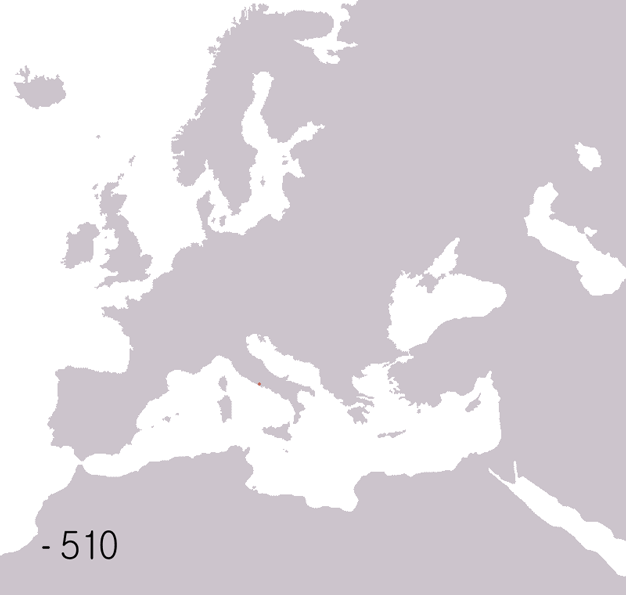 </img>
</img>
Roman Repbulic
Romean Empire
Western Roman Empire
Eastern Roman Empire
Holy Rome Empire, 800/962 ~ 1806.svg.png)
Imperial Banner(c. 1430–1806).svg.png) </img>
</img>
Coat of arms(15th century design)
The double-headed eagle with coats of arms of individual states, the symbol of the Holy Roman Empire (painting from 1510) </img>
</img>
The Holy Roman Empire when the Golden Bull of 1356 was signed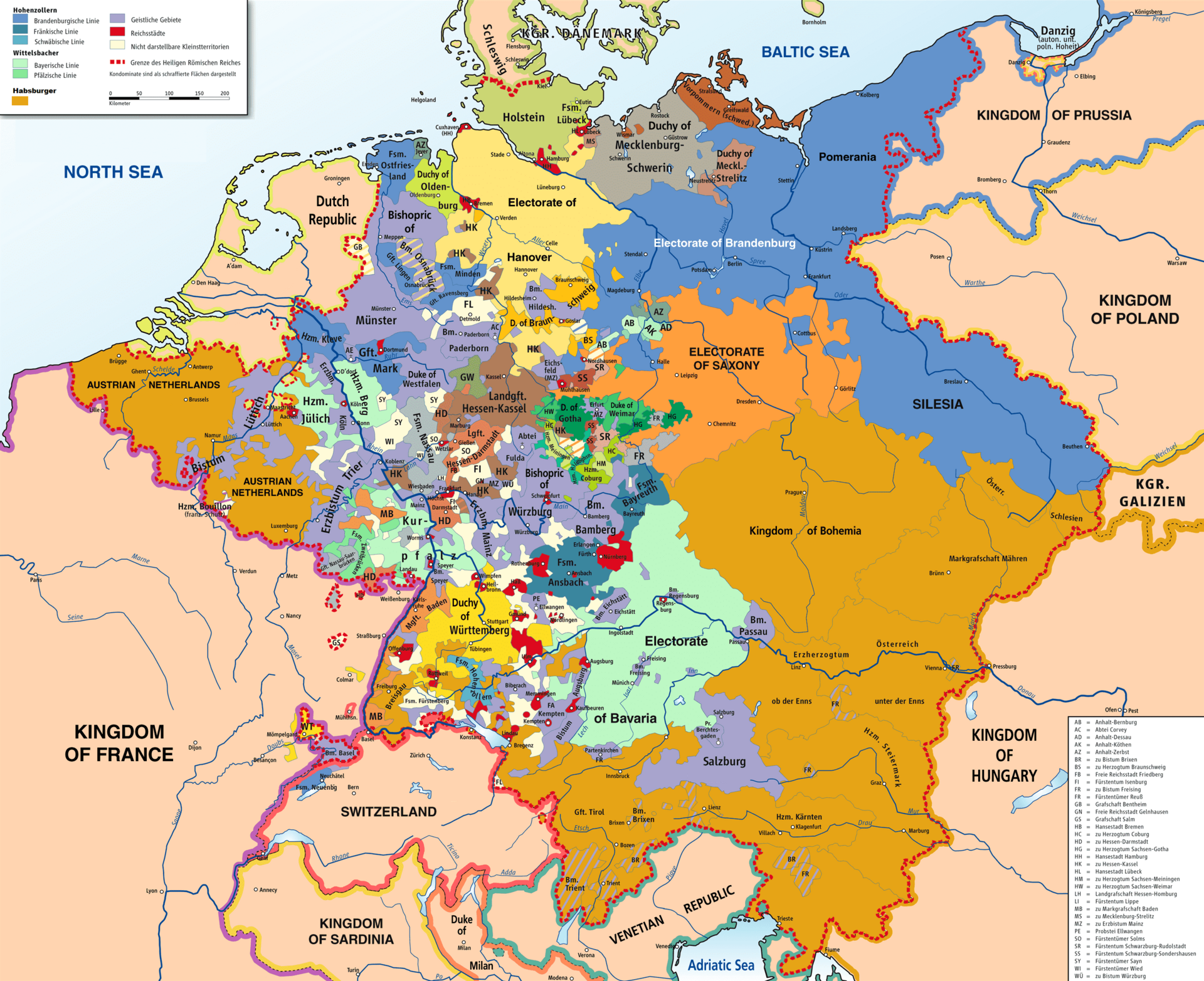
The Empire on the eve of the French Revolution, 1789